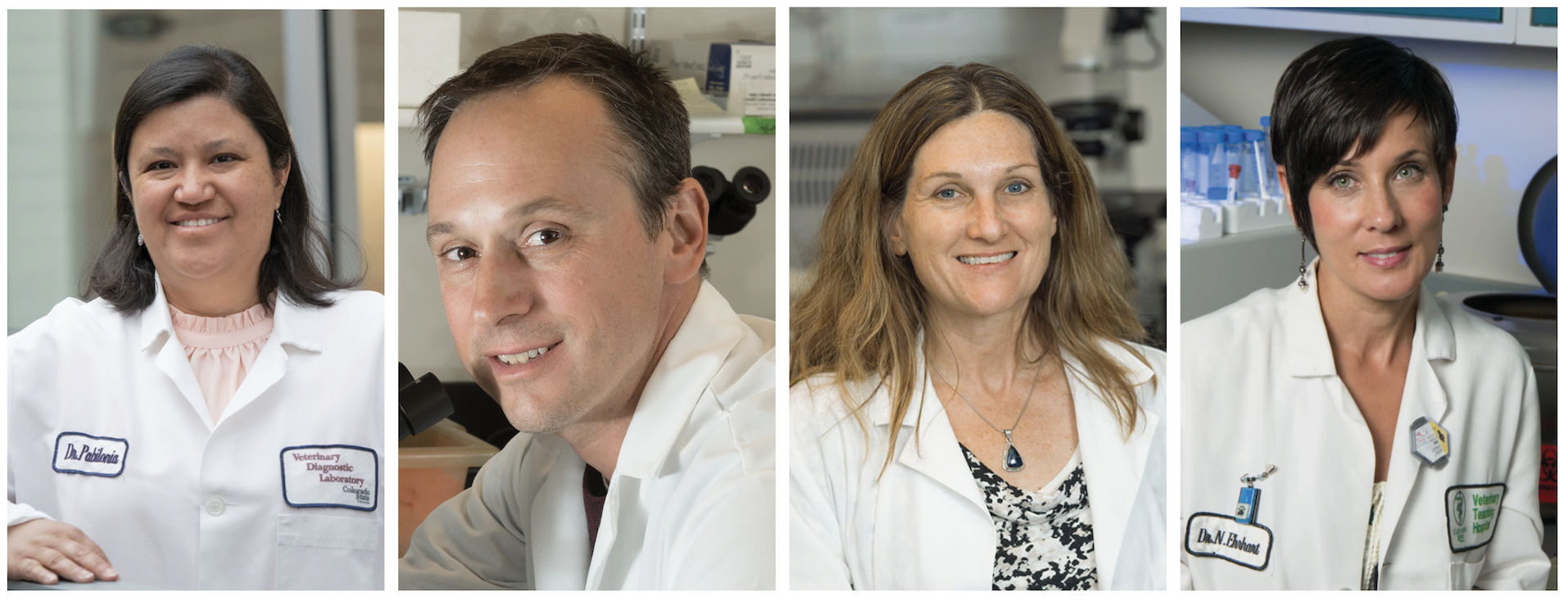
The research team includes, from left, Drs. Kristy Pabilonia, Greg Ebel, Sue VandeWoude and Nicole Ehrhart.
The Columbine Health Systems Center for Healthy Aging at Colorado State University has amassed one of the largest archives of longitudinally collected human samples of COVID-19 through their research in skilled nursing facilities.
In the beginning of the COVID-19 pandemic, when other researchers were in the throes of developing diagnostic tests for COVID or assessing the virus’ infectivity in the population, the Center for Healthy Aging was thinking long-term: How does COVID-19 spread in nursing facilities, and how will the virus behave in the same nursing facility several months from now?
These initial research questions prompted the Longitudinal COVID-19 Screening Study in Senior Care Facilities. Researchers working on the study have now completed nearly 40,000 COVID-19 tests in senior residential care communities throughout Colorado, poising the Center as a national leader in research on how COVID-19 affects older adults and rehab patients in senior nursing facilities.
Asymptomatic spread
The study is fueled by a $4.3 million grant from the State of Colorado, awarded after a spring 2020 pilot study in six senior care facilities showed that the number of new COVID-19 cases within facilities can be decreased by identifying asymptomatic staff or residents who are infected with the SARS-CoV-2 virus that causes COVID-19.
New infections were diminished by asking COVID-19-positive workers to self-isolate. By identifying these silent infections early, the researchers were able to minimize new infections over time, meaning that early detection of asymptomatic infections could be an effective mitigation strategy in the fight against COVID-19.
Genomic sequencing of the virus detected in the pilot research revealed that outbreaks were more often happening because the virus was spreading from person to person within the facility, rather than being repeatedly introduced to the facility via separate events.
With the funding from the state, the pilot study was expanded to 32 facilities that will continue to be tested throughout 2020. Genomic sequencing in the new, expanded cohort will test how the virus spreads under the state’s current “Safer at Home” social guidelines, as compared to the restrictions imposed by the March 2020 stay-at-home order.
In the expanded study, researchers are administering weekly COVID tests to workers and residents, as less-frequent testing has not provided adequate warning of an impending outbreak. The repeated testing of the same workers and residents is where the study gets its longitudinal component, allowing researchers to study questions like: Why do some people recover more quickly from COVID-19 than others? Why are some people asymptomatic whereas others become seriously sick from the virus?
Tracking the virus over time also helps researchers to map the epidemiology and pathology of the virus to know exactly when a person was infected and how far into their infection they might be, which is important in deciding how to treat the virus.
From CSU and beyond
Additional funding from the Boettcher Foundation enabled the researchers to compare how the virus spreads in senior care communities compared to a college campus – in this case, CSU – because it’s likely that “one size does not fit all” when it comes to infection control recommendations and mitigation strategies, says Nicole Ehrhart, director of the CHS Center for Healthy Aging. Ongoing results from this study show that a high percentage of workers in senior care facilities that have had a prior outbreak have antibodies to COVID-19, suggesting that workers have been exposed to the virus in the workplace.
“CSU has been a leader in many aspects of COVID-19 research, and my colleagues, Drs. Greg Ebel, Kristy Pabilonia and Sue VandeWoude, who have been working on these projects with me, have been essential partners in making this effort successful,” Ehrhart said. “With the huge amount of data we have collected, I believe we will continue to answer some of the most pressing questions surrounding the most vulnerable populations and how to best protect these communities.”
Results from the longitudinal screening study are being continually shared with the Colorado Department of Public Health and Environment and have been solicited by the Centers for Disease Control to be shared with investigators in Washington, D.C. Ehrhart says the team often receives requests from researchers to study their dataset, due to its longitudinal design.
Vivage Senior Living and Columbine Health Systems have also been instrumental partners in this ongoing work by actively assisting the research team in collecting data for these studies.